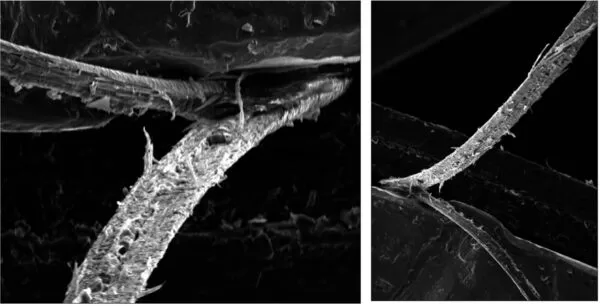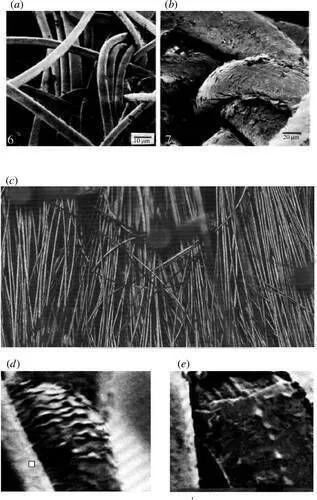Biomechanics of Split Ends: Have you ever wondered why some people seem to perpetually battle split ends, while others enjoy smooth, healthy locks? It turns out, the answer lies in the fascinating science of biomechanics – the study of how forces act on biological structures.

what is science of biomechanics ?
Biomechanics is the science that examines how forces act on biological systems, like the human body or even hair. It combines principles from physics and engineering to understand how these structures move and function.
In the case of hair, biomechanics helps researchers like those at Trinity College Dublin understand how combing or brushing can cause splits. By studying the mechanical forces involved, they can learn why some hair is more prone to damage than others.
Biomechanics of Split Ends: Trinity College Dublin

Researchers at Trinity College Dublin, led by Professor David Taylor, have taken a unique approach to understanding this common hair woe. While academics are often accused of “splitting hairs,” this team has quite literally done just that, developing a machine aptly named the “Moving Loop Fatigue machine.”
This innovative device mimics the stress hair endures during everyday activities like combing or brushing tangled strands. Prior to this invention, the science behind split ends was poorly understood.

The team tested two hair samples: one from someone prone to split ends and another from someone who wasn’t. Using the Moving Loop Fatigue machine, they were able to induce splits in both types of hair. However, the hair susceptible to split ends showed a greater vulnerability, experiencing faster and more extensive splitting.
The research took an interesting turn when they treated the non-splitting hair with bleach. The bleached hair then exhibited similar splitting patterns to the originally split-prone sample. This suggests that chemical treatments, like bleaching, can weaken hair’s structure, making it more susceptible to mechanical damage.

Biomechanics of Split Ends: Isobel Duffy, a researcher on the team
“We were amazed at how well the machine worked,” says Isobel Duffy, a researcher on the team. “It could split a single strand along its entire length, just like what happens to some people’s hair when they style it.” This ability to consistently recreate split ends paves the way for further investigation.
Professor Taylor emphasizes the significance of this research: “This is a first step towards a scientific understanding of hair splitting biomechanics.” Future studies will involve a wider range of hair types, including curly hair, and delve deeper into the effects of environmental factors like humidity and temperature, as well as various hair treatments.
“Hair is a complex material, and surprisingly, we know little about it,” says Professor Taylor. “Our work has the potential to revolutionize hair care for millions of people worldwide, with significant implications for the cosmetics industry.”

This research not only highlights the dedication of scientists who tackle seemingly mundane problems, but also showcases the potential of engineering principles to unlock new knowledge in unexpected areas. As Robert Teeling, another team member, puts it, “I never thought I’d be testing hair during my Masters! But it turned out to be a great project. We learned that hair, like any other material, can break under mechanical stress, and how we treat it matters.”
So, the next time you experience a bad hair day, remember, there’s a whole world of science dedicated to understanding and ultimately solving those frustrating split ends.
FAQs: The Science Behind a Bad Hair Day
Biomechanics of Split Ends: General Questions
- What is biomechanics, and how does it relate to hair? Biomechanics is the study of how forces act on biological structures. In the context of hair, it helps us understand the mechanical forces that can lead to hair damage, such as split ends.
- Why do some people experience more split ends than others? Factors like hair type, chemical treatments (bleaching, dyeing), and environmental conditions can weaken the hair’s structure, making it more susceptible to splitting.
The Science Behind Split Ends
- What is the Moving Loop Fatigue machine? This machine mimics the stress hair endures during combing or brushing, allowing researchers to study the process of hair splitting in a controlled environment.
- How does hair splitting occur? Hair splitting happens when the outer layer of the hair shaft, called the cuticle, becomes damaged or frayed. This can be caused by mechanical stress, chemical treatments, or environmental factors.
- Can split ends be prevented? While it’s difficult to completely prevent split ends, you can minimize their occurrence by:
- Using gentle hairbrushes and combs
- Avoiding excessive heat styling
- Protecting your hair from the sun and other environmental stressors
- Regular trims to remove existing split ends
Biomechanics of Split Ends: Future Research
- What is the future of hair biomechanics research? Future research may explore the effects of different hair care products, styling techniques, and environmental factors on hair health. The goal is to develop innovative products and techniques that can help prevent hair damage and promote healthy hair growth.
- How can this research benefit the cosmetics industry? By understanding the biomechanics of hair damage, the cosmetics industry can develop products that are more effective in protecting and repairing hair. This could lead to the creation of new hair care products that address the specific needs of different hair types and conditions.
Explore more articles like this @ Where And How Resources
